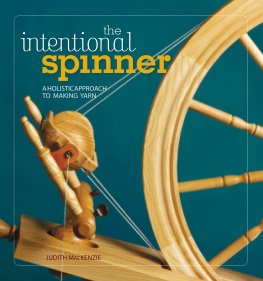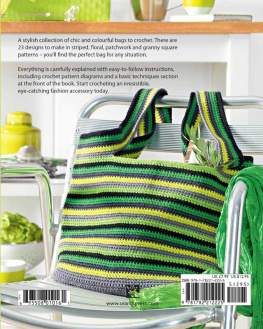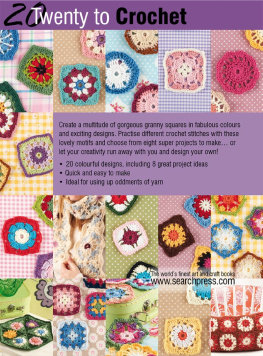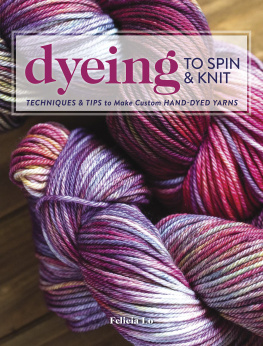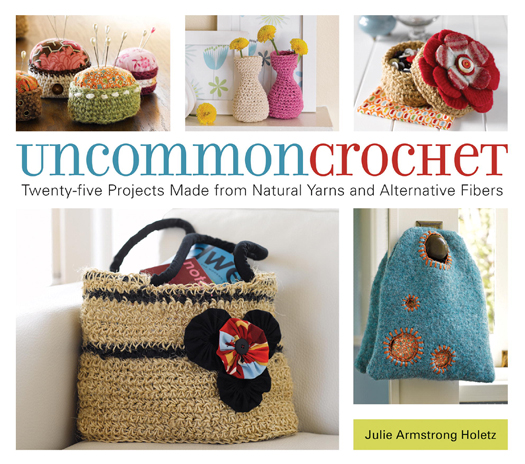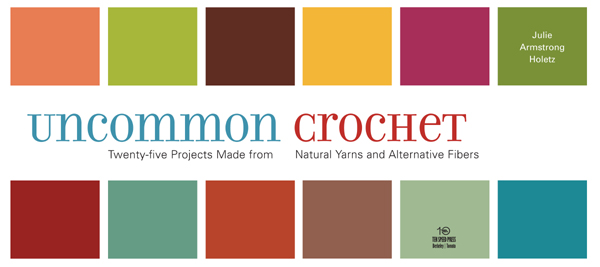All rights reserved. No part of this book may be reproduced in any form, except brief excerpts for the purpose of review, without written permission of the publisher.
Distributed in Australia by Simon and Schuster Australia, in Canada by Ten Speed Press Canada, in New Zealand by Southern Publishers Group, in South Africa by Real Books, and in the United Kingdom and Europe by Publishers Group UK.
Holetz, Julie Armstrong.
Uncommon crochet : twenty-five projects made from natural yarns and alternative fibers / Julie Armstrong Holetz.
p. cm.
Summary: A full-color collection of twenty-five innovative patterns for crocheted bags, vases, containers, totes, baskets, and more, using unconventional yarns and fibersProvided by publisher.
Includes index.
1. Crocheting. 2. CrochetingPatterns. I. Title.
TT825.H546 2008
746.434041dc22
For Steve, whose love, reassurance, patience, and gourmet meals sustain me through everything.
CONTENTS
CREATE
Simple Projects to Spark Your Creativity
DESIGN
The Basics of Shaping
EXPERIMENT
Playing with Fiber
ACKNOWLEDGMENTS
To my editor, Julie Bennett, thank you for your patience, dedication, and attention to detail and for pushing me to go beyond my technical skills to allow my voice to come through. To Angie Cao and Ana Borquez, for a beautiful interpretation of style through the eye of a camera; to Peggi Jeung, its called stylin!; to Betsy Stromberg, for a brilliant design aesthetic and youthful hands; to Amy Swenson, for keen tech editing; to Curtis Lowe, for his invaluable support; to Gertrude and Robert Allen, for the use of their beautiful home; and to all of the fantastic folks rockin it at Ten Speed Press.
Many trays of sashimi go to my good friend Gonzalo Ferreyra. If he had not brought the two Julies together, it is possible that this book never would have been written.
Special thanks go to my friends in the business who have supported me in so many ways: To Kim Werker, for taking a chance at the very beginning. We predicted adventures in crochet, but who knew they would really happen? To Shannon Okey, who is always pushing the boundaries of the business and providing the inspiration and motivation to just go for it (we are the Fiber League!). To Chloe, for your crabby friendship, cartoons, and stories that kept me going in the wee hours of the night. To Josi, Laura, Lisa, Katie, Anne, and Bean, for your support, inspiration, and friendship as creators, businesswomen, and mothers.
Many thanks to Mindy Oliver for her design input; to Jenna for her editing input at the very beginning; to Scott for his advice, food, and babysitting time; to Sue, Rachel, Amy, JoAnn, Angie, Suzanne, and Marti for entertaining the kids so their summer wasnt a complete loss; to Beth who has always been there with her sage advice and confidence in my abilities; to Gordon for being one of my biggest fans; and to my in-laws, who are so encouraging and enthusiastic about all of my projects.
Id like to thank my family, who must be credited with my creative genes: my dad, the visual artist behind the lens; my mom, for whom crafting must involve power tools; and my grandma, who always kept my summers busy with paints, hooks, and needles.
Finally, my eternal love and appreciation go to Ally and Thad, who selflessly banded together to fill their days with something to do while I furiously crocheted.
The 70s defined my childhood: flower power, bell bottoms, feathered hair, and big glasses. My mother was enthusiastic about contemporary American crafts of the time and my grandmother, a more traditional artist, sewed her own clothes and embroidered samplers for the kitchen wall. Between the two of them, I kept busy learning and practicing arts and crafts like macram, sewing, embroidery, rug hooking, and, of course, crochet. As for fiber, anything could and would be used. At that time, traditional wools and acrylics were abundant in bold, incongruous colors, but the needlework artists of the 70s went way beyond the traditional yarns and threads to express their individuality with fiber-like materials, including twine, hemp, raffia, wire, and leather cord.
Becoming a mother of my own little family reminded me of my crafty roots, so once again I turned to crochet. My first project was a dense, crunchy, acrylic baby blanket that saw only four inches of life before it was retired to what would soon become an overflowing, unfinished-projects bin. I desperately searched for contemporary patterns that would inspire me and when I couldnt find them, I turned to knitting. My first completed knit project was an adorable baby sweater pattern I found in a friends old copy of Mon Tricot , a popular needlework magazine from the 70s and 80s. Six weeks later, and fueled with the satisfaction of victory over knitting, I decided that I could have crocheted a similar sweater in a fraction of the time. So, I set about designing my first crochet project.
As I began to master basic crochet and design techniques, I realized I was no longer limited to crocheting long, flat squares and tubes. And I didnt need to find the perfect pattern to inspire meI could create it myself. At first I remained true to the selections of fiber found in the yarn section of my local craft store, but eventually I wanted more. Impressed by crochets seemingly endless design flexibility, I wanted to bend and sculpt more unusual fiber in a way that would highlight or even contradict its nature: imitating woven baskets or ceramic objects with crocheted plant fibers.
As my options for crochet design and materials expanded, so did my collection of stuff. Spools of leather cord bought off the Internet for a steal overflowing tubs of multicolored fabric swatches twisted loops of copper wire, floral wire, and lots of other types of wire I yearned for a way to organize my stash of goods. And so while Id like to say that the projects in Uncommon Crochet were inspired by seventeenth- century French textiles or the Art Nouveau paintings of Gustav Klimt, the truth is I just needed to get the stuff off my bedroom floor.
I started by designing smaller bags and baskets so I could experiment with new fibers and techniques. Then I revisited traditional fibers with a new purpose. Instead of crocheting a project, I wanted to create crocheted fabric that could be cut and sewn like other textiles. I discovered that wool could be felted into a fabric that defies its natural inclination to stretch, and cute felted bowls quickly filled with extra buttons, stray coins, and a surprisingly large collection of safety pins. And when the pins got out of hand, I made pincushions! No container was safe: totes, baskets, vases they can all be crocheted, and Ill show you how.


